小学二年级英语语法归纳
二年级英语知识点苏教版
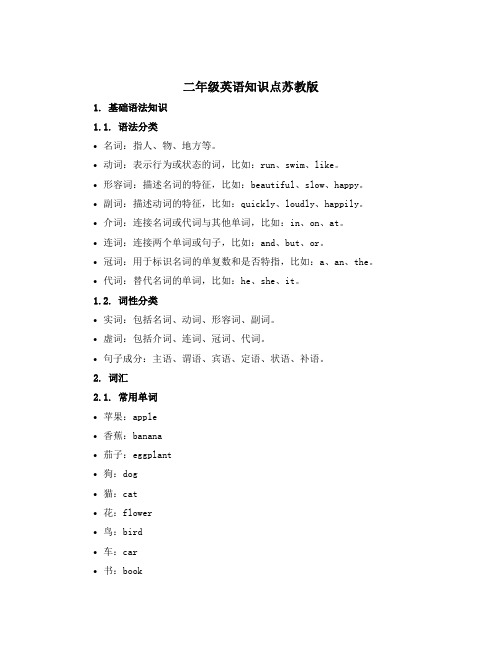
二年级英语知识点苏教版1. 基础语法知识1.1. 语法分类•名词:指人、物、地方等。
•动词:表示行为或状态的词,比如:run、swim、like。
•形容词:描述名词的特征,比如:beautiful、slow、happy。
•副词:描述动词的特征,比如:quickly、loudly、happily。
•介词:连接名词或代词与其他单词,比如:in、on、at。
•连词:连接两个单词或句子,比如:and、but、or。
•冠词:用于标识名词的单复数和是否特指,比如:a、an、the。
•代词:替代名词的单词,比如:he、she、it。
1.2. 词性分类•实词:包括名词、动词、形容词、副词。
•虚词:包括介词、连词、冠词、代词。
•句子成分:主语、谓语、宾语、定语、状语、补语。
2. 词汇2.1. 常用单词•苹果:apple•香蕉:banana•茄子:eggplant•狗:dog•猫:cat•花:flower•鸟:bird•车:car•书:book•英语:English2.2. 常用短语•你好:Hello•再见:Goodbye•谢谢:Thank you•对不起:I’m sorry•非常好:Very good•很高兴见到你:Nice to meet you•请进:Please come in•早上好:Good morning•晚上好:Good evening3. 句型3.1. 简单句•苹果很好吃。
The apple is very tasty.•猫喜欢睡觉。
The cat likes to sleep.•我爱英语。
I love English.•我的书在桌子上。
My book is on the table.3.2. 复合句•我的狗会叫,也会跑。
My dog can bark and run.•看到花,我感到很开心。
I am happy to see the flowers.•我喜欢吃水果,比如苹果和香蕉。
I like to eat fruits, such as apple and banana.4. 阅读和写作4.1. 阅读理解•读一些简单的故事和短文,理解其中的内容。
二年级英语语法的知识点归纳
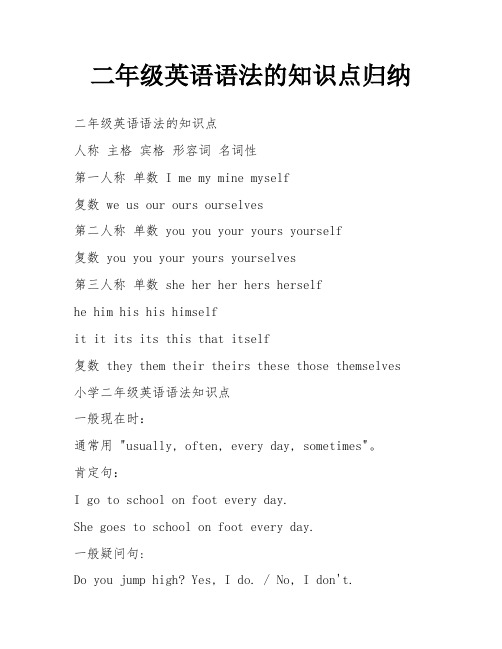
二年级英语语法的知识点归纳二年级英语语法的知识点人称主格宾格形容词名词性第一人称单数 I me my mine myself复数 we us our ours ourselves第二人称单数 you you your yours yourself复数 you you your yours yourselves第三人称单数 she her her hers herselfhe him his his himselfit it its its this that itself复数 they them their theirs these those themselves 小学二年级英语语法知识点一般现在时:通常用 "usually, often, every day, sometimes"。
肯定句:I go to school on foot every day.She goes to school on foot every day.一般疑问句:Do you jump high? Yes, I do. / No, I don't.Does he jump high? Yes, he does. / No, he doesn't.否定句:We don't go to school on Sundays.My mother doesn't like watching TV in the evening.二年级英语语法知识点归纳名词复数规则:1、一般情况下,直接加-s如:book-books, bag-bags, cat-cats, bed-beds2、以s. x. sh. ch结尾,加-es如:bus-buses, box-boxes, brush-brushes, watch-watches3、以“辅音字母+y”结尾,变y为i, 再加-es如:family-families, strawberry-strawberries4、以“f或fe”结尾,变f或fe为v, 再加-es如:knife-knives, wife-wives5、不规则名词复数:man-men, woman-women, policeman-policemen, policewoman-policewomen,mouse-mice, child-children, foot-feet, tooth-teeth,fish-fish, people-peopleChinese-Chinese, Japanese-Japanese。
小学英语语法句型归纳总结

小学英语语法句型归纳总结英语作为一门国际语言,学习英语语法对于小学生来说是至关重要的。
掌握英语语法句型,不仅能够帮助学生更好地理解英语的用法,还能够提高他们的英语表达能力。
下面是对小学英语语法句型的归纳总结:一、简单句型1. 主语 + 动词(及物或不及物)例如:- I eat an apple.(我吃一个苹果。
)- They run in the park.(他们在公园里跑。
)2. 主语 + 动词 + 宾语例如:- She reads a book.(她读一本书。
)- Tom throws a ball.(汤姆扔一个球。
)3. 主语 + 系动词(be动词)+ 表语例如:- I am a student.(我是一个学生。
)- The flower is beautiful.(这朵花很漂亮。
)4. 主语 + 系动词(be动词)+ 地点例如:- The book is on the table.(书在桌子上。
)- The cat is under the chair.(猫在椅子下面。
)二、疑问句1. 一般疑问句使用助动词do、does或did加在句子的主语前,然后再加上动词原形。
例如:- Do you like ice cream?(你喜欢冰淇淋吗?)- Does he play basketball?(他打篮球吗?)2. 特殊疑问句特殊疑问句是用来询问特定信息或细节的问句,通常以疑问代词开头。
例如:- What is your name?(你叫什么名字?)- When is your birthday?(你的生日是什么时候?)- Where do you live?(你住在哪里?)在句子前面加上否定词,通常为don't、doesn't或didn't。
例如:- I don't like pizza.(我不喜欢披萨。
)- He doesn't have a pet.(他没有宠物。
二年级英语语法知识点归纳
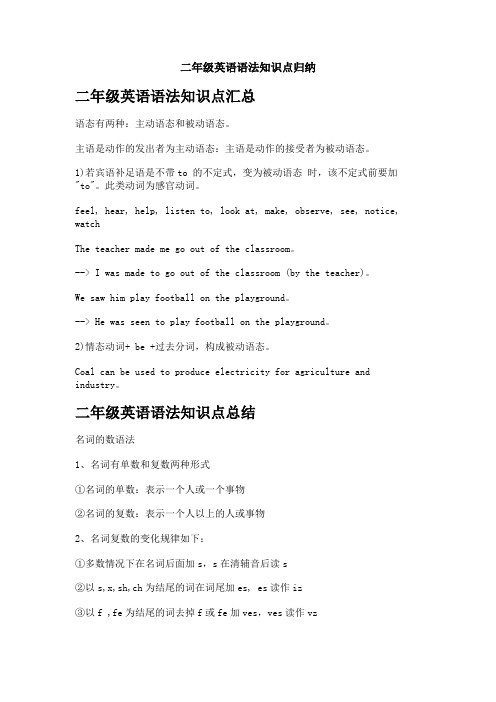
二年级英语语法知识点归纳二年级英语语法知识点汇总语态有两种:主动语态和被动语态。
主语是动作的发出者为主动语态:主语是动作的接受者为被动语态。
1)若宾语补足语是不带to 的不定式,变为被动语态时,该不定式前要加"to"。
此类动词为感官动词。
feel, hear, help, listen to, look at, make, observe, see, notice, watchThe teacher made me go out of the classroom。
--> I was made to go out of the classroom (by the teacher)。
We saw him play football on the playground。
--> He was seen to play football on the playground。
2)情态动词+ be +过去分词,构成被动语态。
Coal can be used to produce electricity for agriculture and industry。
二年级英语语法知识点总结名词的数语法1、名词有单数和复数两种形式①名词的单数:表示一个人或一个事物②名词的复数:表示一个人以上的人或事物2、名词复数的变化规律如下:①多数情况下在名词后面加s,s在清辅音后读s②以s,x,sh,ch为结尾的词在词尾加es, es读作iz③以f ,fe为结尾的词去掉f或fe加ves,ves读作vz④以辅音加y 结尾的词,变y 为ies⑤以元音加y结尾的词,直接加s⑥不规则变化Man-men,woman-women ,policeman-policemen,Policewoman-policewomen这种情况下a变成e⑦单复数同形Chinese-chinese,Japanese-japanese, sheep -sheep ,deer -deer⑧This 这个—these这些(复数), that那个—— those那些(复数), I我—— we我们(复数), he他、she她、 it它——they他、它、她们(复数) am ,is是—— are(复数)二年级英语语法知识点梳理语法总结1. play 与球类搭配时,中间不加the例如: play football 踢足球play basketball 打篮球2. play 与乐器搭配时,中间要加the例如: play the flute 吹笛子、演奏笛子play the drums 打鼓注:play 与乐器搭配时,中间加the,但是也可以加像her, his, my,your,等形容词性物主代词。
小学二年级英语知识点归纳
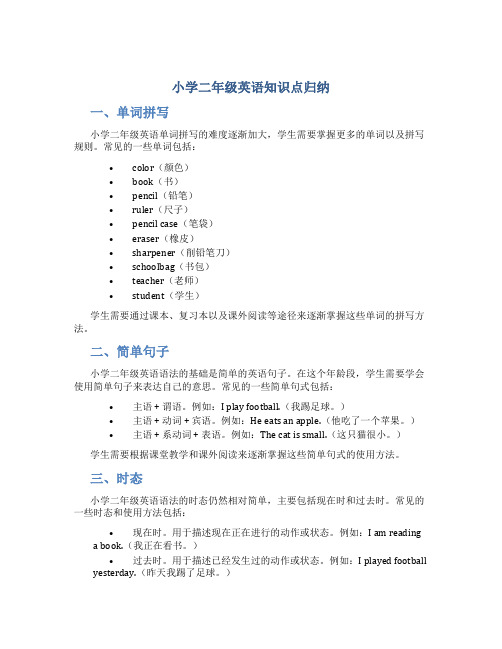
小学二年级英语知识点归纳一、单词拼写小学二年级英语单词拼写的难度逐渐加大,学生需要掌握更多的单词以及拼写规则。
常见的一些单词包括:•color(颜色)•book(书)•pencil(铅笔)•ruler(尺子)•pencil case(笔袋)•eraser(橡皮)•sharpener(削铅笔刀)•schoolbag(书包)•teacher(老师)•student(学生)学生需要通过课本、复习本以及课外阅读等途径来逐渐掌握这些单词的拼写方法。
二、简单句子小学二年级英语语法的基础是简单的英语句子。
在这个年龄段,学生需要学会使用简单句子来表达自己的意思。
常见的一些简单句式包括:•主语 + 谓语。
例如:I play football.(我踢足球。
)•主语 + 动词 + 宾语。
例如:He eats an apple.(他吃了一个苹果。
)•主语 + 系动词 + 表语。
例如:The cat is small.(这只猫很小。
)学生需要根据课堂教学和课外阅读来逐渐掌握这些简单句式的使用方法。
三、时态小学二年级英语语法的时态仍然相对简单,主要包括现在时和过去时。
常见的一些时态和使用方法包括:•现在时。
用于描述现在正在进行的动作或状态。
例如:I am readinga book.(我正在看书。
)•过去时。
用于描述已经发生过的动作或状态。
例如:I played football yesterday.(昨天我踢了足球。
)学生需要通过课堂教学和课外阅读来逐渐掌握这两种时态的使用方法。
四、基本词汇量小学二年级英语学生需要逐渐扩展自己的词汇量。
常见的一些基本词汇量包括:•数字。
例如:one(1)、two(2)、three(3)等。
•颜色。
例如:red(红色)、yellow(黄色)、green(绿色)等。
•动物。
例如:dog(狗)、cat(猫)、bird(鸟)等。
•水果。
例如:apple(苹果)、banana(香蕉)、orange(橙子)等。
小学二年级英语语法汇总

小学二年级英语语法汇总如下:一、基本时态与动词形式1.一般现在时:o使用be动词(am/is/are)描述当前状态或习惯性动作。
o肯定和否定句结构:I am (not) a student. They are (not) playing.o一般疑问句结构及其回答:Are you a student? Yes, I am. / No, I'm not.1.动词的-ing形式:o表示正在进行的动作。
o构成方式:大多数动词加-ing(如walk-walking),以e结尾的动词去e加-ing (如come-coming),以一个元音和一个辅音结尾的重读闭音节动词,双写末尾辅音字母再加-ing(如run-running)。
o句子结构:be + verb-ing(如I am playing football.)。
二、句子结构1.陈述句(声明句):用于陈述事实或表达观点。
o肯定句:I like apples.o否定句:I don't like apples.1.疑问句:用于提出问题。
o一般疑问句:Are you happy?o特殊疑问句(如使用what, where, how等疑问词):What is your name?1.there be句型:用于描述某处存在某物。
o肯定句:There is a book on the table.o否定句:There isn't a book on the table.o疑问句:Is there a book on the table?三、名词与代词1.名词复数规则:o一般情况下,直接加-s(如book-books)。
o以s, x, sh, ch结尾的名词,加-es(如bus-buses)。
o以“辅音字母+y”结尾的名词,变y为i,再加-es(如family-families)。
o以“f或fe”结尾的名词,变f或fe为v,再加-es(如knife-knives)。
二年级英语知识点归纳大全

二年级英语知识点归纳大全一、单词拼写扩展单词量是学习英语的第一步,对于二年级的小朋友们来说,建议从基础单词开始学起,如人称代词I、you、he、she、it等。
二、基础语法二年级的英语语法由简至繁,主要内容包括句子结构、名词和动词的区别、形容词和副词的区别等。
三、常用词组常用词组是小学英语句子表达的基础,如介词短语in front of、behind、on等。
四、数词和数量表达二年级学生需了解基本的数词和数量表达,如数字1-20、颜色、大小等。
五、时间、日期和星期表达英语中的时间、日期和星期表达方式与中文不同,二年级的学生需学会表示时间、日期和星期的相关语句。
六、基础句型二年级学生需学会基础句型,如肯定句、否定句、一般疑问句等,例如,I ama student.(我是一个学生。
)七、常见动词二年级学生需学会常见的动词,如play、eat、drink、run、walk等,通过学习常见动词,学生能够更好地进行语言表达。
八、常见形容词和副词形容词和副词用于描述名词和动词,二年级的学生需学会常见的形容词和副词,如big、small、quickly、slowly等。
九、个人信息表达学生需要会用英语表达自己的个人信息,如姓名、年龄、家庭住址等。
十、经典童谣和儿歌学生可以通过学习经典的童谣和儿歌来培养英语语感和发音,如《Twinkle, Twinkle, Little Star》。
十一、日常用语学生需要学会日常生活中常用的英语语句,如问候语、道别语等。
例如,Good morning!(早上好!)十二、课堂表达学生需要掌握基本的课堂表达方式,如请假、提问等。
以上就是二年级英语知识点归纳大全,希望能帮助孩子们更好地掌握英语知识点,提高英语水平。
小学二年级英语语法总结

小学二年级英语语法总结一、主谓一致主谓一致是指主语和谓语在人称和数上要保持一致。
具体规则如下:1.如果主语是第三人称单数,谓语动词要加-s或-es。
–例如:He plays basketball every day.2.如果主语是第一人称或第二人称,谓语动词不加-s或-es。
–例如:I like ice cream.3.如果主语是复数形式,谓语动词不加-s或-es。
–例如:They go to the park every weekend.二、名词名词是表示人、事物、地方或抽象概念的词语。
在英语语法中,名词有以下几个基本特点:1.名词有单数和复数形式。
–单数形式一般是加-s,如book -> books。
–有些名词复数形式需要变换词尾,如man -> men,child -> children。
2.名词可以用来表示所有关系,有两种形式。
–加’s表示所有关系,如boy’s book。
–加of表示所有关系,如the book of the boy。
3.名词可以用来表示数量或限定范围。
–例如:a book, many books。
三、代词代词是用来代替名词的词语。
在英语语法中,代词有以下几个基本特点:1.主格代词用于代替主语。
–例如:I, you, he, she, it, we, they。
2.宾格代词用于代替动词的宾语。
–例如:me, you, him, her, it, us, them。
3.所有格代词用于表示所有关系。
–例如:mine, yours, his, hers, its, ours, theirs。
4.反身代词用于表示主语和动词的宾语是同一个人或物。
–例如:myself, yourself, himself, herself, itself, ourselves, yourselves, themselves。
四、动词动词是表示动作或状态的词语。
在英语语法中,动词有以下几个基本特点:1.动词有时态和语态的变化。
英语小学生二年级语法的汇总

英语小学生二年级语法的汇总小学生英语语法的重点【现在进行时】1.现在进行时表示现在正在进行或发生的动作,也可表示当前一段时间内的活动或现阶段正在进行的动作。
2.现在进行时的肯定句基本结构为be动词ing。
3.现在进行时的否定句在be后加not。
4.现在进行时的一般疑问句把be动词调到句首。
5.现在进行时的非凡疑问的基本结构为:疑问词不达意 be 主语动词ing但疑问词当主语时其结构为:疑问词不达意 be 动词ing动词加ing的变化规则1.一般情况下,直接加ing,如:cook-cooking2.以不发音的e结尾,去e加ing,如:make-making,taste-tasting3.假如末尾是一个元音字母和一个辅音字母,双写末尾的辅音字母,再加ing,如:run-running, stop-stopping 英语语法知识点【一般过去时态】(a) be 动词的过去式:I/He/she/it was(not). You/we/they were.一般疑问句was, were 放在句首。
(b) 动词过去式:肯定句: I watched cartoons.She visited the zoo.一般疑问句: Did you read book last night Yes, I did. No, I didnt.Did she clean the desk just now Yes, she did. No, she didnt.否定句: They didnt go the the part yesterday.He didnt make model ships last week.(3)动词过去式的变化:规则动词的变化:Most verbs +ed eg. planted,watered,climbed。
Verbs ending in e +d eg liked。
Verbs ending in a consonant +y --y +ied eg : study-studiedShort verbs ending in a vowel + a consonant eg: stop --stopped不规则动词的变化:is/am-was,are-were,do-did,have/has-had,make-made,fly-flew/u:/eat-ate,take-took,run-ran,sing-sang,drink-drank 等等英语二年级的语法【一般现在时】通常用 usually, often, every day, sometimes。
小学二年级英语语法及练习题
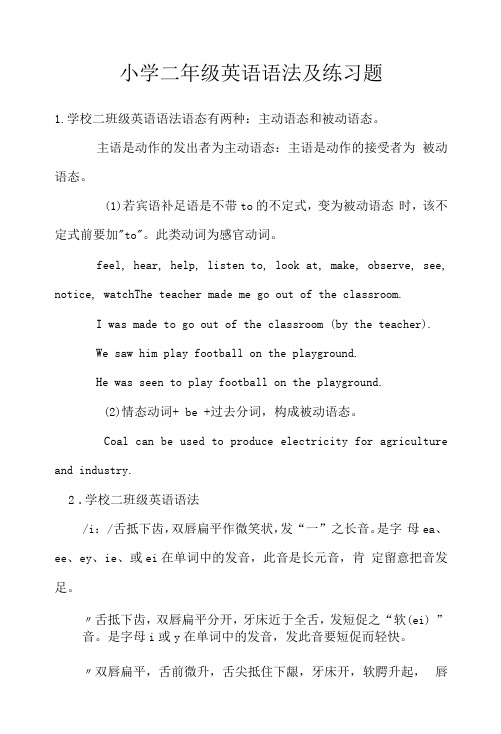
小学二年级英语语法及练习题1.学校二班级英语语法语态有两种:主动语态和被动语态。
主语是动作的发出者为主动语态:主语是动作的接受者为被动语态。
(1)若宾语补足语是不带to的不定式,变为被动语态时,该不定式前要加"to"。
此类动词为感官动词。
feel, hear, help, listen to, look at, make, observe, see, notice, watchThe teacher made me go out of the classroom.I was made to go out of the classroom (by the teacher).We saw him play football on the playground.He was seen to play football on the playground.(2)情态动词+ be +过去分词,构成被动语态。
Coal can be used to produce electricity for agriculture and industry.2.学校二班级英语语法/i:/舌抵下齿,双唇扁平作微笑状,发“一”之长音。
是字母ea、ee、ey、ie、或ei在单词中的发音,此音是长元音,肯定留意把音发足。
〃舌抵下齿,双唇扁平分开,牙床近于全舌,发短促之“软(ei) ”音。
是字母i或y在单词中的发音,发此音要短促而轻快。
〃双唇扁平,舌前微升,舌尖抵住下龈,牙床开,软腭升起,唇自然开放。
是字母a在闭音节或重读闭音节中的发音/e/舌近硬腭,舌尖顶下齿,牙床半开半合,作微笑状。
是字母e 或ea在单词中的发音/3:/舌上抬,唇成自然状态,口半开半闭,发“厄”之长音。
是字母er、ir、or或ur在单词中的发音〃舌上抬,唇成自然状态,口半开半闭,发“厄”之短音。
是字母a、0、u、e、or、er或ur在单词中的发音/a:/双唇张而不圆,牙床大开,舌后微升,舌尖向后升缩微离下齿,发阿之长音。
二年级英语知识点整理归纳

二年级英语知识点整理归纳一、基础知识1. 字母表二年级学生需要熟记26个英文字母的大小写形式及其发音。
在此基础上,掌握字母表排列的顺序,并能熟练拼读和书写单词。
2. 词汇二年级学生需要掌握700个左右的基础词汇。
这些词汇主要涵盖日常生活中的物品、动物、颜色、数字、时间、家庭和衣物等常见内容。
掌握这些词汇能够便于学生进行日常英语的表达和理解。
二、语法知识1. 三单形式三单形式是表示第三人称单数的时态,主要用于谓语动词后。
在三单形式中,动词需要进行变化,例如:•he eat s an apple.(他吃一个苹果。
)•she like s to sing.(她喜欢唱歌。
)2. 一般现在时一般现在时是英语最基本的时态形式之一,主要表示现在发生或习惯性发生的事情。
在这种时态下,主语和谓语动词的形式一般不发生变化,例如:•I go to school every day.(我每天去学校。
)•They like playing football.(他们喜欢踢足球。
)3. 疑问句疑问句是用来询问别人意见、问题或信息的句子。
在构造疑问句的时候,需要使用疑问词,并将主语和谓语动词位置颠倒,例如:•What is your name?(你叫什么名字?)•Do you like ice cream?(你喜欢冰淇淋吗?)三、听说读写技能1. 听听是英语学习的基础技能之一。
二年级学生首先需要能够辨别英语语音,听懂简单的对话和指令,如:•Open your book.(打开你的书。
)•What’s your name?(你叫什么名字?)2. 说说是英语学习的重要技能之一。
二年级学生需要能够用英语句子表达自己的想法和意见,例如:•I have a toy car.(我有一辆玩具车。
)•My favorite color is blue.(我最喜欢的颜色是蓝色。
)3. 读阅读是英语学习的重要技能之一。
二年级学生需要能够读懂简单的英语短文和故事,理解作者想要表达的意思和信息。
二年级英语语法重点知识点
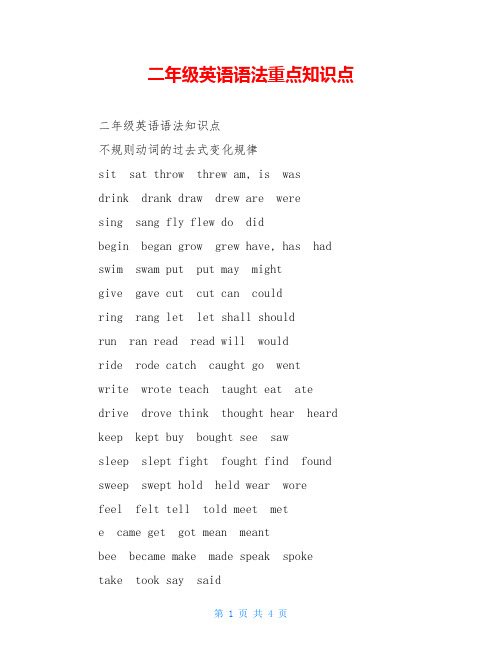
二年级英语语法重点知识点二年级英语语法知识点不规则动词的过去式变化规律sit sat throw threw am, is wasdrink drank draw drew are weresing sang fly flew do didbegin began grow grew have, has had swim swam put put may mightgive gave cut cut can couldring rang let let shall shouldrun ran read read will wouldride rode catch caught go wentwrite wrote teach taught eat atedrive drove think thought hear heard keep kept buy bought see sawsleep slept fight fought find found sweep swept hold held wear worefeel felt tell told meet mete came get got mean meantbee became make made speak spoketake took say said1)is, am -was are-were2) begin-began ring-rang drink-drank swim-swam give-gavesing-sang sit-sat run-ran have-had make-madee-came eat-ate3) write-wrote ride-rode speak-spoke drive-drove stand-stoodtell-told win-won get-got take-took4) sleep-slept sweep-swept feel-felt keep-keptspell-spelt spend-spent bend-bentmeet-met go-went5) know-knew fly-flew blow-blew grow-grewthrow-threw draw-drew (glow-glowed)6) teach-taught catch-caught buy-boughtfight-fought think-thought7) find-found hear-heard say-said lie-laysee-saw learn-learnt mean-meant8) put-put read-read cut-cut let-let英语二年级英语语法学习方法规则动词的过去式词尾读音a.在浊辅音和元音后读[d],如lived, watered, listened, played。
小学英语二年级语法大全
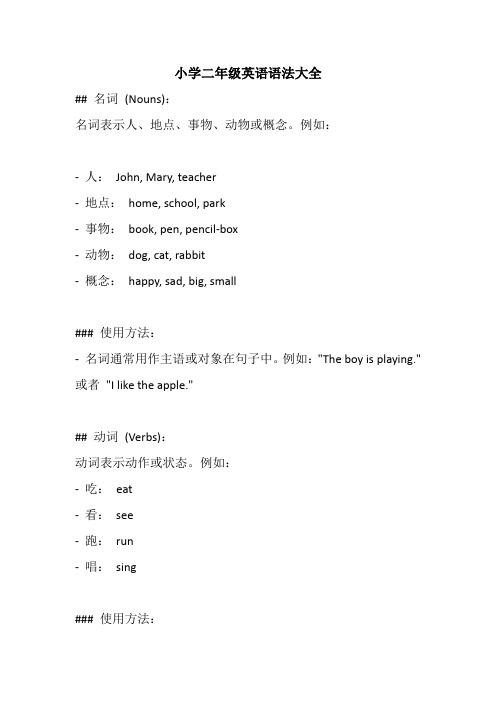
小学二年级英语语法大全## 名词(Nouns):名词表示人、地点、事物、动物或概念。
例如:-人:John, Mary, teacher-地点:home, school, park-事物:book, pen, pencil-box-动物:dog, cat, rabbit-概念:happy, sad, big, small### 使用方法:-名词通常用作主语或对象在句子中。
例如:"The boy is playing." 或者"I like the apple."## 动词(Verbs):动词表示动作或状态。
例如:-吃:eat-看:see-跑:run-唱:sing### 使用方法:-动词通常后面跟宾语,表示动作的承受者。
例如:"I eat an apple." 或者"She sees a cat."## 形容词(Adjectives):形容词描述名词,表示颜色、大小、形状、数量等。
例如:-大:big-小:small-红:red-圆:round### 使用方法:-形容词通常用来修饰名词。
例如:"The big red ball." 或者"He has a small round face."## 副词(Adverbs)副词用来修饰动词、形容词或其他副词,表示时间、地点、方式或程度。
例如:-快:fast-慢慢地:slowly-在这里:here-非常:very### 使用方法:-副词放在它所修饰的词之前或之后。
例如:"She runs fast." 或者"Here is your book."以上只是英语语法的一小部分,对于小学二年级的学生来说,最重要的是通过实际的练习和使用,逐渐熟悉并掌握这些规则。
希望这份文档能对你有所帮助!。
二年级英语的语法知识点归纳.doc

二年级英语的语法知识点归纳二年级英语的语法知识点归纳1:宾语一、名词作宾语Show your passport, please.请出示护照。
二、代词作宾语He didn t say anything.他什么也没说。
三、数词作宾语How many do you want? - I want two.你要几个?- 我要两个。
四、名词化的形容词作宾语They sent the injured to hospital.他们把伤员送到医院。
五、不定式或ing形式作宾语They asked to see my passport.他们要求看我的护照。
I enjoy working with you.我和你们一道工作很愉快。
六、从句作宾语Did you write down what he said?你把他的话记下了没有?二年级英语的语法知识点归纳2:名词一、定义名词是表示人或事物名称的词。
它既可以表示具体的东西,也可以是表示抽象的东西。
二、分类1. 名词可以根据意义分为普通名词和专有名词如:John is a studentstudent是普通名词,John是专有名词普通名词前可以用不定冠词a/an, 定冠词the 或不加冠词,专有名词前一般不加冠词,专有名词的首字母要大写。
2. 普通名词又可以分为个体名词、集体名词、物质名词和抽象名词,其中个体名词与集体名词是可数名词,物质名词和抽象名称是不可数名词。
3. 专有名词专有名词是表示人名、地名、团体、机构、组织等的专有名词,多为独一无二的事物。
三、名词的数1、名词分为可数名词和不可数名词。
可数名词可以数的名词不可数名词数不清(没有复数)Drink?milk tea water orange juice coke coffee porridgeFood?rice bread meat fish fruit cake dumplings2、可数名词与不定冠词a(an)连用有数数形式,不可数名词不能与不定冠词a(an)连用,没有复数形式many+可数名词复数much/a little+不可数名词some, any , a lot of (lots of) 两者都可以修饰。
最新二年级英语语法知识点整理
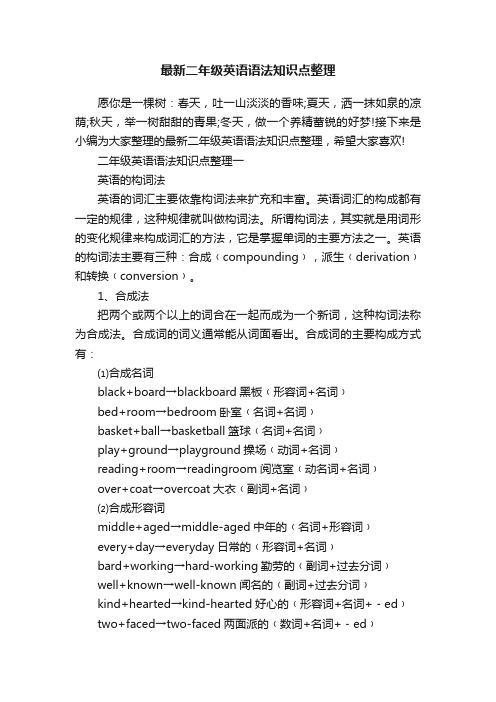
最新二年级英语语法知识点整理愿你是一棵树:春天,吐一山淡淡的香味;夏天,洒一抹如泉的凉荫;秋天,举一树甜甜的青果;冬天,做一个养精蓄锐的好梦!接下来是小编为大家整理的最新二年级英语语法知识点整理,希望大家喜欢!二年级英语语法知识点整理一英语的构词法英语的词汇主要依靠构词法来扩充和丰富。
英语词汇的构成都有一定的规律,这种规律就叫做构词法。
所谓构词法,其实就是用词形的变化规律来构成词汇的方法,它是掌握单词的主要方法之一。
英语的构词法主要有三种:合成﹙compounding﹚,派生﹙derivation﹚和转换﹙conversion﹚。
1、合成法把两个或两个以上的词合在一起而成为一个新词,这种构词法称为合成法。
合成词的词义通常能从词面看出。
合成词的主要构成方式有:⑴合成名词black+board→blackboard黑板﹙形容词+名词﹚bed+r oom→bedroom卧室﹙名词+名词﹚basket+ball→basketball篮球﹙名词+名词﹚play+ground→playground操场﹙动词+名词﹚reading+room→readingroom阅览室﹙动名词+名词﹚over+coat→overcoat大衣﹙副词+名词﹚⑵合成形容词middle+aged→middle-aged中年的﹙名词+形容词﹚every+day→everyday日常的﹙形容词+名词﹚bard+working→hard-working勤劳的﹙副词+过去分词﹚well+known→well-known闻名的﹙副词+过去分词﹚kind+hearted→kind-hearted好心的﹙形容词+名词+﹣ed﹚two+faced→two-faced两面派的﹙数词+名词+﹣ed﹚⑶合成副词some+times→sometimes有时﹙形容词+名词﹚may+be→maybe大概﹙情态动词+动词﹚up+stairs→upstairs在楼上﹙副词+名词﹚for+ever→forever永远﹙介词+副词﹚⑷合成代词①不定代词+名词somebody﹙someone﹚omethingnobody﹙noone﹚everythinganybody﹙anyone﹚anythingnothingeveryoouy﹙everyone﹚②代词宾格或物主代词+self﹙selves﹚herselfourselves⑸合成动词white+wash→whitewash粉刷﹙形容词+动词﹚over+come→overcome克服﹙副词+动词﹚sleep+walk→sleepwalk梦游﹙名词+动词﹚2、派生法在一个单词﹙词根﹚的前或后加上一个词缀,构成一个新词,这种构词法称为派生法。
小学二年级的英语语法口诀.doc

小学二年级英语语法口诀1.数词变化规律及读法口诀两大数词基和序,前表数量后第几。
构成先谈基数词, 1 至 12 请认真记。
13 至 19teen 结尾齐, ty 结尾表示几十。
若要表达几十几,几十短横 1 到9。
One hundred 一百记,若表几百几十几。
几百and 几十几,基数规律上述里。
再把序数谈仔细,第一至三独立记。
第四至十九结尾th,第廿到九十有规律。
基数基础 y 变 ieth。
第几十几有特例,第几十由基数起,几用序数有道理。
第一百 one hundred。
若说第一百几十几。
One hundred and 第几十几。
谈此即告一段落。
2.一般现在时用法及句型转换口诀经常习惯动作和真理,是一般现在时的定义。
构成除单三皆动原式。
若逢动词第三人称体,动词变单三式有道理。
若要变成否定的形式,动词原形之前加 don’除t,单三人称外无特例。
单三式前 doesn’t动原基。
句首 Do,Does 疑问起, Does 用单三人称限制,单三还原形没大问题。
3.变动词单三人称口诀一般情况动词尾 -s 加。
O,s,ch,sh结尾“-es”没有差。
辅音加 y 去 y 为“-ies ”是方法。
4现在分词构成口诀词尾直加 -ing 是一般式,若遇无音 e 去之加 -ing。
重读闭音一辅音字母尾,双写该字母-ing 是正里。
5.感观使役动词记忆和使用口诀1.记忆口诀:二听四看一感觉,使役动词有三个。
或:一感二听三使四看。
一感;feel 二听: hear,listen to 三使:make ,let ,have四看: look at,see,watch,notice使用口诀:感使动词真奇怪,to 在句中象妖怪。
主动句里它走开,被动句里它回来。
动词 let 要除外, to 词可来可不来。
6.时刻表达法口诀时刻表达法作用大,衣食住行离不开它。
整点时把点钟数打,时分俱全不好表达。
请记下列几种方法:先时后分莫给弄差。
若要说明几点过几分,可把past 和 after 来抓。
二年级英语语法的知识点

一、动词的时态1.现在时态现在时态表示现在正在进行的动作或者客观事实。
常见的现在时态动词有is/am/are。
例如:I am a student.(我是学生。
)2.过去时态过去时态表示过去发生的动作或状态。
常见的过去时态动词有was/were。
例如:He was a teacher last year.(他去年是一名老师。
)3.将来时态将来时态表示将来要发生的动作。
常见的将来时态动词有will/shall。
例如:I will go to the park tomorrow.(我明天去公园。
)二、名词的单复数1.单数名词单数名词表示一个人、动物、物体或者概念。
一般情况下,单数名词前不加任何限定词。
例如:a cat(一只猫)2.复数名词复数名词表示多个人、动物、物体或者概念。
一般情况下,复数名词在词尾加-s或-es。
例如:two cats(两只猫)三、代词代词用来替代名词,可以简化语句结构。
常见的代词有人称代词、物主代词和指示代词。
1.人称代词人称代词用于表示说话人、被说话人和被谈论的人。
常见的人称代词有I、you、he/she/it等。
例如:I am a student.(我是学生。
)2.物主代词物主代词用来表示所有权。
常见的物主代词有my、your、his/her/its等。
例如:This is my book.(这是我的书。
)3.指示代词指示代词用来指示一些人或物。
常见的指示代词有this、that、these、those等。
例如:This is a pen.(这是一支笔。
)四、形容词形容词用来描述名词的性质或特征。
形容词一般放在名词前面。
常见的形容词有big、small、happy等。
例如:He has a big house.(他有一幢大房子。
)五、副词副词用来修饰动词、形容词或其他副词。
副词通常放在动词或形容词的后面。
常见的副词有quickly、slowly、happily等。
例如:She runs quickly.(她跑得快。
- 1、下载文档前请自行甄别文档内容的完整性,平台不提供额外的编辑、内容补充、找答案等附加服务。
- 2、"仅部分预览"的文档,不可在线预览部分如存在完整性等问题,可反馈申请退款(可完整预览的文档不适用该条件!)。
- 3、如文档侵犯您的权益,请联系客服反馈,我们会尽快为您处理(人工客服工作时间:9:00-18:30)。
小学二年级英语语法归纳
1. What can you do? I can sing.
2. What is that in the net? It's a mouse.
3. What can you see? I can a net.
4. What can you see, Tom? I can see a bee.
5. What colour is your pencil case? It's blue.
6. What's this? It's an apple.
7. What's on the desk? There are books.
8. What's in your room? There is a bed in my room.
9. What's your name? My name is Xiao jia.
10. What's on your desk? The book on my desk.
11. What colour is your bag? It is pink.
12. What's that in your hand? It is pencil.
13. What animal do you like? I like monkey and zebra.
14. What dose it like? It likes to eat fish.
1. How are you? I'm fine. Thank you.
2. How are you today? I'm very well. Thank you.
3. How is the weather? It's windy.
4. How old are you? I'm seven.
5. How many chairs? There are seven chairs.
6. How many spoons? There is one.
7. How many bowls in your kitchen? Ten.
1. Can you skip a rope? Yes, I can.
2. Can your father swim? No, he can't.
3. Can you see a big net? No, I can't.
4. Can you clean your room? Yes, I can.
5. Can you keep your classroom clean? Yes, I can.
1. Is it a big cat? No, it's a samll cat.
2. Is the snake big? Yes, it is.
3. Is your hair long? Yes, I am. No, I am not.
4. Is your room big? No, it isn't. Yes, it is.
5. Is he your brother? No, he isn't.
6. Is she your sister? Yes, she's my sister.
7. Is that a boy? Yes, he's a boy.
8、Is she thin? No,she is fat.
9、Is he Danny? Yes,he is Danny.
1、Are you a boy? No,I'm a girl.
2、Are you nine?No,I'm seven.。
